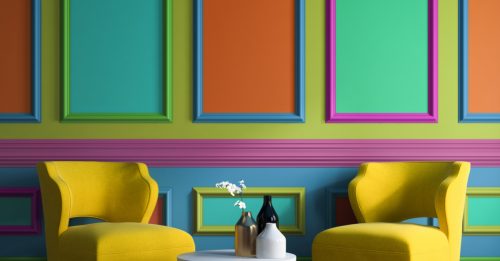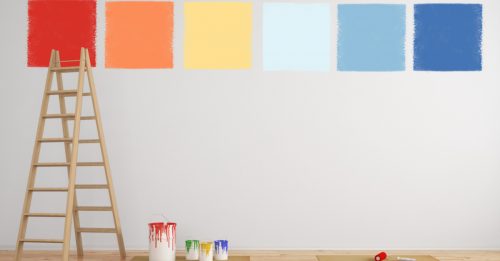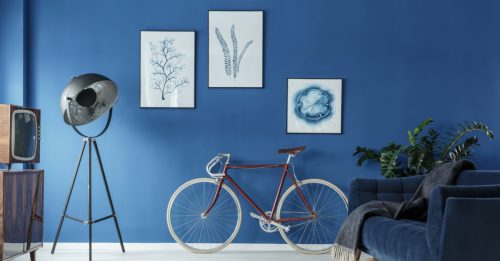6 Suggestions for Choosing the Color of your Walls

The color of your walls needs to be changed every now and then. You should think about changing it because sometimes you need to refresh the mood in your home.
On many occasions, you can satisfy this need for renovation and refreshment by changing around a few things. For example, the layout of the furniture in the room, or the color of your accessories such as cushions, blankets, curtains, etc.
Giving new color to your walls means a total visual renovation
So, every now and then you should consider renovating the mood or feel of your house. You can change something so simple and at the same time so complex as the color of your walls.
In this article we will give you 6 basic and simple suggestions to help you choose the color of your walls.
1. Don’t follow fashions
This might seem odd at first, but we’ll explain why.
As you well know, we live in a world that is progressing very quickly. Today you have one fashion, tomorrow another and you can be overwhelmed by trying to keep up with new trends.
As regards to colors, every year new trend colors come out. Choose colors because you like them and, among other things, because they will go well with the room you want to paint.
If you choose the color of your walls to keep up with current fashions, you’ll have to be constantly changing them.
2. What room are you going to paint?
This aspect is very important when it comes to choosing one color or another. Before going to the hardware store or paint shop to choose the color, think about the following:
- Size of the room: lighter colors go better in smaller rooms because they give the sense of more space. On the other hand, darker colors visually reduce the size of the living space.
- Luminosity: obviously if your room has a lot of natural light, you will want to capitalize on it. So you could always choose lighter tones. It is true however, that dark colors can also provide a contrast if there is a lot of natural light.
If the room doesn’t have much light coming into it, you should choose light colors that will invigorate the room.
- Regular or irregular: if you already know that you want to use the same color throughout for all the walls, you won’t have to think about this.

But on the other hand, if you’re thinking of painting the walls in different colors, you should take into account that in irregular rooms this doesn’t always suit.
- Use of the room: this will also influence you when choosing the color of your walls. For example if you are going to use a room as a child’s bedroom, for a couple, for an office or for the living room, this will affect your color choice.
3. Take into account the whole, not just the parts
The paint on your walls can drastically change the visual ambiance of the room.
It’s important when changing the color of the walls that you still have a harmonious environment. The color, the style and the furnishings should complement each other to perfection.
So that there can be harmony in your living space, think about if you want a contrast between the different furnishings and the walls, or if you want a similar tone throughout.
4. What do I want to transmit?
You most likely know that colors can transmit different sensations. This is taught in the idea of color psychology.
It’s important to take this into account if you’re very selective when choosing colors. Depending a great deal on the color you choose for your walls, your room can transmit peace, tranquility, creativity, energy or intensity.

Make sure you have clearly in mind what sensations you want to transmit before choosing the color of your walls.
5. Types of paint
There are many types of paint that exist and it’s always best if you use a professional to help you choose.
In the following part, we will show you the different types of paint. We will also look at their most common uses so you can arrive at the paint shop with a basic idea.
- Acrylic water based paint: this is one of the most commonly used indoor paints due to its easy application and rapid drying. It also doesn’t have a very strong smell.
You’ll find a huge range of colors in this type of paint.
- Synthetic paint: this type of paint is much more resistant than the previous type. Take into account that it dries somewhat slower.
The good thing is that it can be cleaned easily, although you will need to use a solvent to clean it. Its smell is a little stronger, but with a mask and good ventilation it shouldn’t be a problem.
- One-coat paint: it’s the expensive version of water based paint. As its name shows, with this you can cover the surface of the walls using just one layer of paint.
It’s best if you use it on walls without imperfections.
- Eco-friendly paint: for those concerned with the environment and pollution, this paint is ideal since it’s made from natural sources and/or minerals and not from petroleum.
- Anti-fungicide paint: this type of paint is very special because it has characteristics that make it very hygienic.
Anti-fungicide paints have the capacity to avoid mold, humidity and bacteria appearing on its surface that can sometimes grow on normal painted surfaces. It’s a good option in places where hygiene is fundamental, such as the kitchen or bathroom.
6. Choose the finish for the color of your walls
Paint, depending on its type, can have different sheens or finishes.
It’s important to choose the appropriate finish for your walls so they can be a spectacular feature of your home.
- Flat or matte finish: this finish is very pretty and is coming more and more into fashion, but you should know that it doesn’t reflect much light. Due to this, it might not be a good idea to choose this paint for rooms with very little light.

- Satin finish: the principal advantage of this finish is that it’s easy to clean.
- Semi-gloss: this is recommended for walls that don’t have any, or hardly any, imperfections. The shine will show up any defects.
Conclusion
To round this article off, we want to encourage you to renovate the mood of your home every now and then.
Be patient because it’s a process that requires a little time and forethought for you to achieve the desired effect.
Are you a creative person, and want to reflect that in your walls? You could also opt for some paint texturing effects such as rag painting, sponging, or color washing.
The color of your walls needs to be changed every now and then. You should think about changing it because sometimes you need to refresh the mood in your home.
On many occasions, you can satisfy this need for renovation and refreshment by changing around a few things. For example, the layout of the furniture in the room, or the color of your accessories such as cushions, blankets, curtains, etc.
Giving new color to your walls means a total visual renovation
So, every now and then you should consider renovating the mood or feel of your house. You can change something so simple and at the same time so complex as the color of your walls.
In this article we will give you 6 basic and simple suggestions to help you choose the color of your walls.
1. Don’t follow fashions
This might seem odd at first, but we’ll explain why.
As you well know, we live in a world that is progressing very quickly. Today you have one fashion, tomorrow another and you can be overwhelmed by trying to keep up with new trends.
As regards to colors, every year new trend colors come out. Choose colors because you like them and, among other things, because they will go well with the room you want to paint.
If you choose the color of your walls to keep up with current fashions, you’ll have to be constantly changing them.
2. What room are you going to paint?
This aspect is very important when it comes to choosing one color or another. Before going to the hardware store or paint shop to choose the color, think about the following:
- Size of the room: lighter colors go better in smaller rooms because they give the sense of more space. On the other hand, darker colors visually reduce the size of the living space.
- Luminosity: obviously if your room has a lot of natural light, you will want to capitalize on it. So you could always choose lighter tones. It is true however, that dark colors can also provide a contrast if there is a lot of natural light.
If the room doesn’t have much light coming into it, you should choose light colors that will invigorate the room.
- Regular or irregular: if you already know that you want to use the same color throughout for all the walls, you won’t have to think about this.

But on the other hand, if you’re thinking of painting the walls in different colors, you should take into account that in irregular rooms this doesn’t always suit.
- Use of the room: this will also influence you when choosing the color of your walls. For example if you are going to use a room as a child’s bedroom, for a couple, for an office or for the living room, this will affect your color choice.
3. Take into account the whole, not just the parts
The paint on your walls can drastically change the visual ambiance of the room.
It’s important when changing the color of the walls that you still have a harmonious environment. The color, the style and the furnishings should complement each other to perfection.
So that there can be harmony in your living space, think about if you want a contrast between the different furnishings and the walls, or if you want a similar tone throughout.
4. What do I want to transmit?
You most likely know that colors can transmit different sensations. This is taught in the idea of color psychology.
It’s important to take this into account if you’re very selective when choosing colors. Depending a great deal on the color you choose for your walls, your room can transmit peace, tranquility, creativity, energy or intensity.

Make sure you have clearly in mind what sensations you want to transmit before choosing the color of your walls.
5. Types of paint
There are many types of paint that exist and it’s always best if you use a professional to help you choose.
In the following part, we will show you the different types of paint. We will also look at their most common uses so you can arrive at the paint shop with a basic idea.
- Acrylic water based paint: this is one of the most commonly used indoor paints due to its easy application and rapid drying. It also doesn’t have a very strong smell.
You’ll find a huge range of colors in this type of paint.
- Synthetic paint: this type of paint is much more resistant than the previous type. Take into account that it dries somewhat slower.
The good thing is that it can be cleaned easily, although you will need to use a solvent to clean it. Its smell is a little stronger, but with a mask and good ventilation it shouldn’t be a problem.
- One-coat paint: it’s the expensive version of water based paint. As its name shows, with this you can cover the surface of the walls using just one layer of paint.
It’s best if you use it on walls without imperfections.
- Eco-friendly paint: for those concerned with the environment and pollution, this paint is ideal since it’s made from natural sources and/or minerals and not from petroleum.
- Anti-fungicide paint: this type of paint is very special because it has characteristics that make it very hygienic.
Anti-fungicide paints have the capacity to avoid mold, humidity and bacteria appearing on its surface that can sometimes grow on normal painted surfaces. It’s a good option in places where hygiene is fundamental, such as the kitchen or bathroom.
6. Choose the finish for the color of your walls
Paint, depending on its type, can have different sheens or finishes.
It’s important to choose the appropriate finish for your walls so they can be a spectacular feature of your home.
- Flat or matte finish: this finish is very pretty and is coming more and more into fashion, but you should know that it doesn’t reflect much light. Due to this, it might not be a good idea to choose this paint for rooms with very little light.

- Satin finish: the principal advantage of this finish is that it’s easy to clean.
- Semi-gloss: this is recommended for walls that don’t have any, or hardly any, imperfections. The shine will show up any defects.
Conclusion
To round this article off, we want to encourage you to renovate the mood of your home every now and then.
Be patient because it’s a process that requires a little time and forethought for you to achieve the desired effect.
Are you a creative person, and want to reflect that in your walls? You could also opt for some paint texturing effects such as rag painting, sponging, or color washing.







